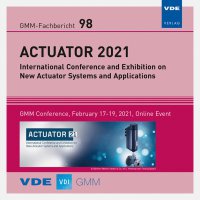Hybrid dynamical model for elastocaloric heating and cooling device based on Shape Memory Alloy wires
Conference: ACTUATOR - International Conference and Exhibition on New Actuator Systems and Applications 2021
02/17/2021 - 02/19/2021 at Online
Proceedings: GMM-Fb. 98: ACTUATOR 2021
Pages: 4Language: englishTyp: PDF
Authors:
Mandolino, Michele Arcangelo; Welsch, Felix; Kirsch, Susanne-Marie; Rizzello, Gianluca (Intelligent Material Systems Laboratory, Department of Systems Engineering, Department of Materials Science and Engineering, Saarland University, Saarbrücken, Germany)
Michaelis, Nicolas; Schuetze, Andreas (Lab for Measurement Technology, Department of Systems Engineering, Saarland University, 66123 Saarbrücken,)
Seelecke, Stefan; Motzki, Paul (Intelligent Material Systems Laboratory, Department of Systems Engineering, Department of Materials Science and Engineering, Saarland University, Saarbrücken, Germany & Center for Mechatronics and Automation Technologies (ZeMA) gGmbH, Saarbrücken, Germany)
Abstract:
In this paper, a hybrid dynamical model for Shape Memory Alloy (SMA) wire actuators is used to develop a computationally efficient simulation framework for solid-state thermo-mechanical cooling devices. The hybrid model is grounded on a physical description of the SMA based on the Müller-Achenbach-Seelecke model, which consists of a set of ordinary differential equations (ODEs) describing the dynamic evolution of phase fractions via statistical thermodynamics concepts. Although the hybrid model is originally developed to simulate the actuation behavior of SMAs, its physical nature makes it suitable to investigate the elastocaloric effect (ECE) as well. In this work, the new hybrid model is integrated within a previously developed set of thermo-mechanically coupled equations, which describe a continuously operating elastocaloric fluid cooling system based on SMAs. The implementation of the hybrid model is carried out in MATLAB environment through an extension of the Hybrid Equation (HyEQ) Toolbox. After the model implementation, a comparative simulation campaign is carried out to quantify the benefits due to the hybrid dynamical model. Improvements of simulation times up to one order of magnitude with no significant losses of accuracy are reported.


